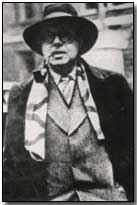Who's Who - Percy Wyndham Lewis
 Percy Wyndham Lewis
(1882-1957) served as an official British artist during the First World War
in addition to serving as a battery officer.
Percy Wyndham Lewis
(1882-1957) served as an official British artist during the First World War
in addition to serving as a battery officer.
Born in Nova Scotia in 1882 Lewis was educated in England at the renowned Rugby School. Thereafter accepted into Slade School of Art in 1898 Lewis graduated in 1901 and embarked upon a tour of Europe, eventually returning to England in 1909.
Lewis established a reputation as a man of parts: aside from his undoubted talent as an artist he published essays, plays and novels, and came to be regarded as a satirist.
In 1912 Lewis founded Vorticism, a new literary and artistic movement of sharp angles and bold lines which went out of its way to reject the 'irrelevant' romanticism of the nineteenth century, instead stressing qualities such as violence and energy together with the increasing importance of mechanical machines in the modern world. Supporters of his group included another artist who would serve in an official capacity during wartime, Christopher Nevinson.
Lewis's First World War service included two years spent on the Western Front as a battery officer from 1916-18. In 1937 he published his wartime memoirs as Blasting and Bombardiering. Lewis was also approached by Lord Beaverbrook to paint A Canadian Gun Pit - one of his best known works - for the Canadian War Memorial. In 1919 Lewis unveiled his best-known war painting, A Battery Shelled.
Having developed increasingly right-wing views in the post-war years, Lewis viewed developments in Germany during the 1930s with something approaching enthusiasm. He was associated with the British Fascist Party. Such views led to his biographer Jeffrey Meyers describing Lewis as "'one of the loneliest figures in the intellectual history of the thirties".
Renewed war in 1939 resolved Lewis to return to his homeland of Canada. With his sight failing he was obliged to give up painting, eventually becoming blind. Instead he continued to write, penning the autobiographical Self-Condemned in 1954.
He died in 1957.
"Beachy Bill" was the name given to one of the Turkish guns which regularly shelled Anzac Cove.
- Did you know?
